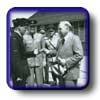Royal Australian Air Force (RAAF)
 For
the Australians on their way to Canada, their journey often
began with a grueling train ride across their own vast country. Coming from all over the continent, the Australian heat and lack of
sleeper cars made for some uncomfortable trips. For
the Australians on their way to Canada, their journey often
began with a grueling train ride across their own vast country. Coming from all over the continent, the Australian heat and lack of
sleeper cars made for some uncomfortable trips.
Next came a boat trip across the Pacific. Sailing to an
unknown destination somewhere on west coast North America,
the ships took a roundabout route in order to skirt areas
known to be active with Japanese submarines. To hide at
night, the ships were blacked out and smoking was
prohibited after a certain hour.
The Australians usually disembarked in California. If they
were lucky, they would get to spend a few hours or a day
in San Francisco before hopping on a train for the 30-hour
trip to Alberta. In its entirety, the journey from Australia to Alberta
took several weeks.
 Australians,
like their counterparts from New Zealand, came to Canada
to attend Service
Flying Training School (SFTS). Australians completed
their initial and elementary flying in Australia. 9,666 Australians
came to train in Canada overall, including over 4,000 who
became pilots (the total number of Australians pilots in
World War II numbered approximately 15,000). Australians Australians,
like their counterparts from New Zealand, came to Canada
to attend Service
Flying Training School (SFTS). Australians completed
their initial and elementary flying in Australia. 9,666 Australians
came to train in Canada overall, including over 4,000 who
became pilots (the total number of Australians pilots in
World War II numbered approximately 15,000). Australians
also
trained as navigators, navigator/bombers, air bombers,
air
gunners and wireless operator/air gunners. Australia spent
$65 million on the Plan.
 At some rather tender ages—some recruits were just past
their 18th birthdays—these men found themselves
over 20,000 kilometres from their home and families. There
was no airmail to Australia at that time and surface mail
took weeks to go back and forth between Alberta and Australia.
Many did find surrogate families in Alberta, aided by notice
boards, which were full of invitations. They also found
community in their fellow Aussies. Trainees from other countries
observed that they were fiercely loyal to one another. At some rather tender ages—some recruits were just past
their 18th birthdays—these men found themselves
over 20,000 kilometres from their home and families. There
was no airmail to Australia at that time and surface mail
took weeks to go back and forth between Alberta and Australia.
Many did find surrogate families in Alberta, aided by notice
boards, which were full of invitations. They also found
community in their fellow Aussies. Trainees from other countries
observed that they were fiercely loyal to one another.
 In
wintertime, Australian trainees could be set apart by their
uniforms, which were a unique shade of deep blue, as opposed
to the dull grey of the other divisions. Unfortunately,
their summer gear was the same khaki as everyone else,
although one group did manage to escape this fate. And, while nicknames abounded among all the divisions,
the Australians seemed to come up with the most creative
monikers. One group, for instance, included a Bob "Shagger"
Clarke, a Ken "100% Good" Wright, a Keith "Horizontal" Quirk
and an "Ozzie" Osbourne. In
wintertime, Australian trainees could be set apart by their
uniforms, which were a unique shade of deep blue, as opposed
to the dull grey of the other divisions. Unfortunately,
their summer gear was the same khaki as everyone else,
although one group did manage to escape this fate. And, while nicknames abounded among all the divisions,
the Australians seemed to come up with the most creative
monikers. One group, for instance, included a Bob "Shagger"
Clarke, a Ken "100% Good" Wright, a Keith "Horizontal" Quirk
and an "Ozzie" Osbourne.
Click here for some first hand impressions.


|
 Heritage Community Foundation Presents
Heritage Community Foundation Presents Heritage Community Foundation Presents
Heritage Community Foundation Presents